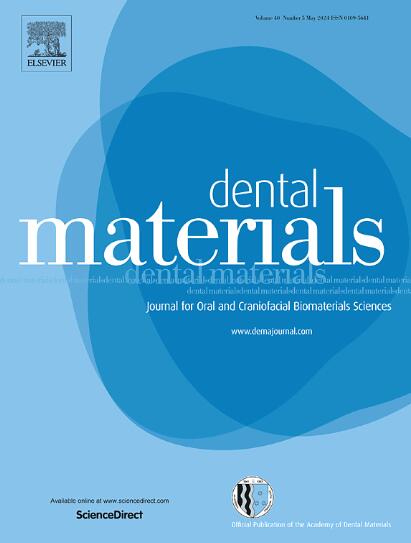抗阿尔茨海默氏症药物 GSK-3β 拮抗剂对树脂-牙本质界面能量耗散数值模型的影响。
IF 4.6
1区 医学
Q1 DENTISTRY, ORAL SURGERY & MEDICINE
引用次数: 0
摘要
研究目的本研究旨在确定浸润了掺有替格鲁西布(TDg)的聚合物纳米粒子(NPs)(TDg-NPs)的条件牙本质的粘弹性能和能量耗散情况:方法:在牙本质条件表面渗入 NPs 和 TDg-NPs。制作粘接界面,保存 24 小时,并接受机械和热学挑战。通过纳米 DMA/复合物损耗储存模量-谭三角评估和原子力显微镜(AFM)分析对树脂-牙本质界面进行评估:结果:渗入 NPs 并循环加载的牙本质在混合层和混合层底部的复合模量最高。用未掺杂的 NPs 处理过的管间牙本质在加载循环后比管周牙本质显示出更高的复合模量,从而引起能量集中和界面破裂。渗入 TDg-NPs 后,管周牙本质和管间牙本质的复合模量相似,能量耗散均匀。使用 TDg-NPs 和负载循环后,管间牙本质的 Tan delta 值高于管周牙本质。这就产生了最宽的胶原纤维带宽和桥状矿物结构,作为能量耗散的视线,它们加速了活跃的牙本质重塑。热循环后,TDg-NPs 引发了稀少的矿化,但这些桥接过程限制了界面的破坏区:重要意义:基于 TDg 的 NPs 可从粘弹性角度有效实现牙本质再矿化和管状密封。本文章由计算机程序翻译,如有差异,请以英文原文为准。
Effect of the anti-Alzheimer drug GSK-3β antagonist on numerical modeling of the energy dissipation through the resin-dentin interface
Objectives
The aim of this study was to determine the viscoelastic performance and energy dissipation of conditioned dentin infiltrated with polymeric nanoparticles (NPs) doped with tideglusib (TDg) (TDg-NPs).
Methods
Dentin conditioned surfaces were infiltrated with NPs and TDg-NPs. Bonded interfaces were created, stored for 24 h and submitted to mechanical and thermal challenging. Resin-dentin interfaces were evaluated through nano-DMA/complex-loss-storage moduli-tan delta assessment and atomic force microscopy (AFM) analysis.
Results
Dentin infiltrated with NPs and load cycled attained the highest complex modulus at hybrid layer and bottom of hybrid layer. Intertubular dentin treated with undoped NPs showed higher complex modulus than peritubular dentin, after load cycling, provoking energy concentration and breakdown at the interface. After infiltrating with TDg-NPs, complex modulus was similar between peri-intertubular dentin and energy dissipated homogeneously. Tan delta at intertubular dentin was higher than at peritubular dentin, after using TDg-NPs and load cycling. This generated the widest bandwidth of the collagen fibrils and bridge-like mineral structures that, as sight of energy dissipation, fastened active dentin remodeling. TDg-NPs inducted scarce mineralization after thermo-cycling, but these bridging processes limited breakdown zones at the interface.
Significance
TDg-based NPs are then proposed for effective dentin remineralization and tubular seal, from a viscoelastic approach.
求助全文
通过发布文献求助,成功后即可免费获取论文全文。
去求助
来源期刊

Dental Materials
工程技术-材料科学:生物材料
CiteScore
9.80
自引率
10.00%
发文量
290
审稿时长
67 days
期刊介绍:
Dental Materials publishes original research, review articles, and short communications.
Academy of Dental Materials members click here to register for free access to Dental Materials online.
The principal aim of Dental Materials is to promote rapid communication of scientific information between academia, industry, and the dental practitioner. Original Manuscripts on clinical and laboratory research of basic and applied character which focus on the properties or performance of dental materials or the reaction of host tissues to materials are given priority publication. Other acceptable topics include application technology in clinical dentistry and dental laboratory technology.
Comprehensive reviews and editorial commentaries on pertinent subjects will be considered.
 求助内容:
求助内容: 应助结果提醒方式:
应助结果提醒方式:


